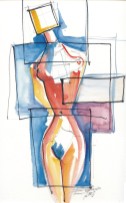Although it is a widely acknowledged fact in the scientific community that women are playing an increasingly important role in the media, a more thorough analysis of this phenomenon is required; its mechanisms and above all its effects have to be questioned. The aims of this conference are therefore twofold. The first is to offer a more detailed insight into the relative positions of women and men in the different sectors of the press, in various kinds of newsroom, in specialist journalism, and in positions of power. The second is to consider the possible transformations in journalistic output that might be brought about by increased female participation in journalism, and more generally, to understand the stakes and effects of gender relationships in the division of labour both in newsrooms and in the process of news production.
In France for example, in parallel with the growth in the number of journalists (a 23% increase between 1997 and 2006) and their level of qualifications, we are also witnessing increasing female participation in the profession. Women currently account for 43% of all French Press Card holders and 53% of first applications for Press Cards. However, inequality is still rife; women (4.5%) are more often unemployed than men (3.7 %) and they are more often freelance (22.1% compared to 16.1% for men), but they rarely hold publishing director positions (0.5% compared to 2.1% for men). Going beyond these general data on the media, how might we refine the analysis of the role of women and men in the newspapers? What are the different mechanisms behind these persistent gender inequalities? We especially need to consider whether women’s access to the more dominated positions in the journalistic world is the only – or main – factor; or whether, and how, other variables enter into the equation. The specificity of certain press sectors, especially the women’s press, magazines, and alternative media, and the place occupied by women inside these media would be of great interest. The challenge will also be to get to grips with the concrete mechanisms that intervene in the division of labour within newsrooms, in the promotion process and in access to senior positions.
We also need to consider the effects of this increased female presence on journalistic output. This probably requires us to stop questioning the existence of “feminine writing” or the “specificity” of women, and to concentrate on the gender assignment mechanisms of specific topics and thematic specialisation (for example, by distinguishing between various sectors of the written press, such as between the general interest sector, the feminine sector and an alternative), and on gender relationships in the process of news production. To what extent women do themselves choose to work on themes that are pre-constructed as feminine? And to what extent is this allotment due to the process of editorial control? Are gender divides rigid or do they vary in time and space? Are the uses of feminine themes always in accordance with dominant models or could they subvert gender codes? To what extent does anticipation of the readership’s gender representations and of the advertisers’ expectations matter?
The papers presented during this international conference will endeavour to illustrate the way gender influences journalistic work at the editorial and organisational levels, using field work (observations, interviews, content analysis) as their basis. To that end, we are interested in papers in three main areas:
* The male/female breakdown in the different press sectors, the gender mechanisms of assignment and their changes, in relation with morphological transformations in journalism;
* The gender issue in human resources management, in access to senior positions, linked to changes in legislation, structural changes in the press, and the makeup of readership and advertising markets in the different press sectors;
* Gender and the assignment of journalistic subjects and specialisations and journalistic skill building mechanisms, in relation to the social construction of so-called feminine or masculine aptitudes.
Paper proposals (one page max.) and a brief curriculum vitae should be sent to the organisers by 15 October 2007:
ü Béatrice Damian-Gaillard (damian@univ-rennes1.fr)
ü Cégolène Frisque (cegolene.frisque@univ-nantes.fr)
ü Eugénie Saitta (eugeniesaitta@yahoo.fr





Gender, Journalism and the Press
I am a Nigerian journalist and I just completed an MA in Communication here in Washington DC.
I am interested in presenting a paper at the conference on: Media and Bias: How the Media Misrepresent Women.